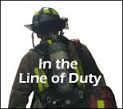
Background
In December 2011 a Fire Officer was fatally injured as the result of an explosion in a metal storage container (Sea Can). The storage container was being used to store a limited number of gasoline-fuelled tools and also housed approximately one litre of methyl hydrate. The locked container was exposed to direct fire impingement and radiant heat caused by a wood frame building burning directly onto 3 sides of the container. The resulting heat transferred to the container caused some combustible material inside the storage unit to ignite and fuel tanks on some of the gas powered tools to fail allowing gasoline to escape to the atmosphere. At some point after that the required gasoline-to-air mixture was achieved and an ignition source provided. The explosion caused the container to catastrophically fail, severing both doors and depositing them both over 40 meters from the storage container. One of the doors came into contact with the Fire Officer, causing the fatal injuries. The explosion occurred well into the incident, an estimated 2 hours after the arrival of fire department resources.
The Fire Code and Regulations
Storage of Flammable/Combustible liquids for Incidental Use in Ancillary Outdoor Enclosures:
- A fire safely plan developed in cooperation with local fire department is required in all buildings and open areas where flammable/combustible liquids are stored, handled, or used. [BCFC Div. B, 4.1.5.5.]
- Ventilation of an enclosed space is required to conform to BCFC Div. B, 4.1.7.2. if open
- containers are stored. Ventilation of an enclosed space is not required if Class 1 flammable liquids are stored in closed containers. [BCFC Div. B, 4.1.7.2.(2)]
- Note: Closed container means a container sealed by a means of a lid or other device such that neither liquid nor vapour will escape from it at ordinary temperatures. [BCFC Div. A 1.4.1.2.]
- Where the storage of flammable/combustible liquids are secondary to the principal activity, the limit of flammable/combustible liquids in closed containers that can be outside of storage cabinets is 600L, of which only 100L can be Class 1A liquid(s). [BCFC Div. B, 4.2.8.]
Discussion
The fire investigators concluded that the amount of flammable liquids stored in this storage unit was well within the amount permitted by the British Columbia Fire Code. In this incident extenuating factors led to the catastrophic failure of the container. Two of those factors were:
1. Extreme external heating of a non-combustible closed storage container;
2. Structural characteristics that initially contained the explosion until the weakest part of the unit failed.
These structures can pose a unique and previously unidentified risk to fire service personnel when responding to fires where these metal storage containers (Sea Cans) are present. It is recognised that these containers are used extensively throughout the province and under most circumstances do not represent significant issues. However in some circumstances special precautions should be considered by responding fire personnel when the potential for an explosion exists or may exist.
Advisory
- These storage units should be listed in the owner’s fire safety plan and any amount of flammable liquids or hazardous materials identified. Dangerous Goods placards affixed to the exposed sides of the container would provide responders with information regarding any hazardous contents.
- Fire Departments should include in the pre-fire plan the content of such containers, their locations on the lot and proximity to combustible structures that may contribute to excessive heating of the storage unit should adjacent materials be ignited.
- The hazard must be recognised in the initial size-up of the incident and measures taken to isolate the hazard or modify firefighter suppression tactics. If there is flame impingement/exposure to any structure, container or vessel it should be investigated, assessed and monitored throughout the incident.
- Unmanned hose streams and distance from the storage unit should be considered if there is or has been significant direct or indirect heat applied to the container by the fire. These storage units or containers should be given the same consideration as pressure vessels when flammable or combustible liquids are suspected to be stored inside. Many of these containers are unable to vent when sealed and therefore greater exclusion zones should be maintained at weaker points of the containers, such as doors, where the container would be most likely to fail.
- Whenever possible the owner should be encouraged to provide some physical separation between these containers and combustible structures or other fire loads to prevent excessive heating during fire situations.
Contact: Office of the Fire Commissioner
Emergency Management BC
PO Box 9201 Stn Prov Govt
Victoria BC V8W 9J1
1-888-988-9488